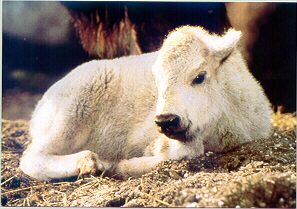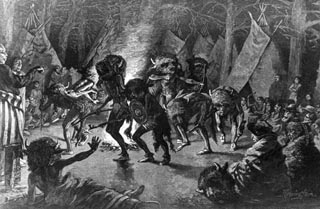 |
Manifest Destiny |
 |
Broadsides |
 |
Buffalo |
 |
Cultures |
 |
Population |
 |
Resources |
|
|
Science
Ohio SLC 15: Explain how living things interact with the living and non-living components of the environment.
Benchmark B: Explain how climate, weather, and the supply of food and water impact populations.
Art:
Currier and Ives Art Print and Catlin Print. The art teacher can introduce lithographic art and famous artists of the time period.
The buffalo were an important resource on the Great Plains of the American
West. Why did Native Americans hunt Buffalo? Why did the settlers hunt
buffalo? What happened to the buffalo? What impact did this have on the
Native American way of life? What impact did this have on the environment?
Use these prints and photographs as starting points in your research.

|

Click on the picture to link |
Buffalo hunt- chase
Photographic
reproduction of a print from the "North American Indian Portfolio" by
George Catlin
A Native American
(Plains) man chases a buffalo on horseback. The man draws a loaded bow. |
Hunting on the Plains.
New York: Published by
Currier & Ives, c1871.
Man on horseback
with rifle riding next to bison. |
The Library of Congress:
History of the American West
Evolution of the Conservation Movement
|

Click on the picture to link |

Click on the picture to link |
Geronimo carving buffalo meat for
his Indians [1909]
Geronimo, a Native American (Chiricahua Apache) man, stands near a slain
buffalo in Oklahoma. Other men and boys, some of whom wear feather headdresses,
stand nearby. One man holds a staff decorated with feathers. |
Painted buffalo hide
Native American
(Mandan) painted bison hide shows: scenes of hunters with rifles, shields,
or bows and arrows, some wear feather headdresses; one on horseback. Collected
by Maximilian Prince of Wied from the upper Missouri riverbanks around
1844. |
The Library of Congress: History of
the American West |

|
One of the many uses for buffalo
hides, fur coats. [188-?]
Two men with long
buffalo hide coats, standing in photograph studio. No identification given,
likely in North Dakota. |
|
Language Arts and Social Studies:
Analyze and interpret the letter from Thoedore Roosvelt. Do you think
the buffalo should have been shot or given to a zoo? Write a paper supporting
you viewpoint.

Click on the picture to link |
Last buffalo killed in North Dakota, January 1907
: Casselton, North Dakota.
Men and boys in
winter coats standing by fence behind a buffalo. Rope tied around horns
of buffalo and held by man.
"My dear Mr.
Lynch: I thank you for your gift, and appreciate it. And yet I am really
sorry that you had to kill that buffalo bull. I am surprised that there
should have been no market for him in the different parks and museums
of this country, for I would have thought there would be plenty of people
who would like to have him. With regard and thanks, I am, Sincerely yours,
Theodore Roosevelt"--Text of letter written by President Theodore
Roosevelt from the White House, January 28, 1907. |
|
Language Arts
Read the story about the white buffalo calf. What is a myth? Write the
story in your owns words or write your own myth.
|
Miracle, The Sacred White Buffalo
Born August 20, 1994
The Heider Farm ~ Janesville, Wisconsin
Miracle's
Website
Not an albino, she is considered to be the first white buffalo calf
born since 1933.
Legend of the
White Buffalo (PBS)
This is a story about a beautiful woman who gives the people a sacred
pipe with twelve feathers.
|
Unified Arts:
Dance, music, art, physical education. Students can learn the buffalo
dance steps either in a physical education or dance class. In music class,
you can study various types of American Indian music and then perform
a short piece.
|
|
|

















